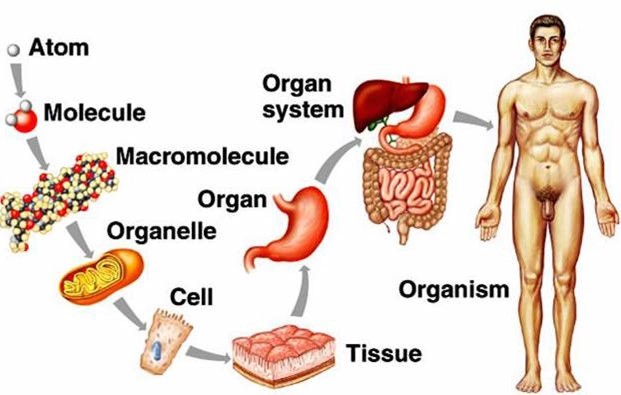Which of the following lists best illustrates the idea of increasing levels of complexity?
Organs, organelles, organ systems, cells, tissues.
Cells, tissues, organelles, organs, organ systems.
Organelles, cells, tissues, organs, organ systems.
Tissues, cells, organs, organelles, organ systems.
The Correct Answer is C

This list best illustrates the idea of increasing levels of complexity because it follows the biological hierarchy of organization from the simplest to the most complex units of matter.
Each level is composed of units from the previous level and has emergent properties that are not present in the lower levels.
Choice A is wrong because it reverses the order of organelles and cells. Organelles are subcellular structures that perform specific functions within cells.
Cells are the basic units of life that can carry out all the processes of living organisms.
Choice B is wrong because it reverses the order of tissues and organelles. Tissues are groups of similar cells that work together to perform a common function. Organelles are more basic than tissues and are found within cells.
Choice D is wrong because it reverses the order of organs and organelles.
Organs are structures composed of two or more types of tissues that perform a specific function or function.
Organelles are more basic than organs and are found within cells.
Nursing Test Bank
Naxlex Comprehensive Predictor Exams
Related Questions
Correct Answer is B
Explanation
This is because erythroblastosis fetalis, also known as hemolytic disease of the newborn, is caused by Rh incompatibility between the mother and the fetus.
Rh incompatibility occurs when a Rh-negative mother is impregnated by a Rh-positive father, resulting in a Rh-positive fetus.
The mother’s immune system can detect the Rh factor on the fetus’s red blood cells as foreign and produce antibodies against them.
These antibodies can cross the placenta and destroy the fetus’s red blood cells, causing anemia, jaundice, edema, and other complications.
Choice A is wrong because a second Rh-negative fetus developing in an Rh-negative woman will not cause erythroblastosis fetalis.
The mother and the fetus have the same Rh factor, so there is no immune reaction.
Choice C is wrong because a first Rh-positive fetus developing in an Rh-negative woman will not cause erythroblastosis fetalis.
The mother’s immune system will not produce antibodies against the Rh factor until after the first exposure to it, which usually happens during delivery.
Therefore, the first pregnancy is usually unaffected.
Choice D is wrong because a first Rh-negative fetus developing in an Rh-negative woman will not cause erythroblastosis fetalis.
The mother and the fetus have the same Rh factor, so there is no immune reaction.
The normal range of red blood cell count for newborns is 4.1 to 6.1 million cells per microliter of blood.
The normal range of bilirubin level for newborns is 0.3 to 1.9 milligrams per deciliter of blood.
Correct Answer is B
Explanation
The correct answer is choice B. False.
Arteries are strong, elastic vessels that carry blood away from the heart, except for the coronary arteries that supply blood to the heart muscle.
These are the first arteries to branch off the aorta, which is the main artery that takes blood to the body from the left ventricle.
Choice A is wrong because it contradicts the definition of arteries. Arteries carry blood away from the heart, not to the heart.
Whether you are a student looking to ace your exams or a practicing nurse seeking to enhance your expertise , our nursing education contents will empower you with the confidence and competence to make a difference in the lives of patients and become a respected leader in the healthcare field.
Visit Naxlex, invest in your future and unlock endless possibilities with our unparalleled nursing education contents today
Report Wrong Answer on the Current Question
Do you disagree with the answer? If yes, what is your expected answer? Explain.
Kindly be descriptive with the issue you are facing.
